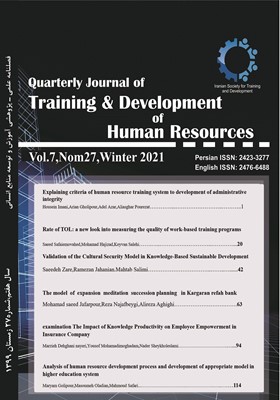Analysis of human resource development process and development of appropriate model in higher education system
Subject Areas : روش های نوین آموزش وتوسعه منابع انسانیMasumeh Oladian 1 * , Maryam Golipour 2 , Mahmoud Safari 3
1 - Azad University
2 - Azad
3 - Azad University
Keywords: Higher education system human resource development human resource development process analysis,
Abstract :
The purpose of this study was to analyze the process of human resource development and to develop an appropriate model in the higher education system and its method in a mixed way (qualitative and quantitative). The research community in the qualitative part consisted of professors, specialists and experts in this field and in the quantitative part consisted of professors, experts, experts and managers of the higher education system. In the qualitative section, which was purposefully selected, 12 professors, specialists and experts were selected, and in the quantitative section, 382 experts and managers of the higher education system were selected using the Cochran's formula. The research tools were semi-structured interview and researcher-made questionnaire. Analysis of collected data, in the qualitative part by grounded theory method and through coding using MAXQDA software and in the quantitative part by descriptive and inferential methods using SPSS 16 software And Smart PLS was done. The results showed that twelve components are involved in explaining the human resource development process and developing an appropriate model in the higher education system, which are: Self-efficacy, self-esteem, motivation, empowerment, organizational learning, organizational culture, knowledge management, technology, job satisfaction, community development, facilitating networking, and ultimately human capital development. To check the fit of the model, check the X2, R and RS; It was discussed that the presence of low X2 and the ratio of chi-square to the degree of freedom less than three, as well as the coefficient of determination and the adjusted coefficient of determination were calculated; Indicates the proper fit of the model.
1. Abbaspour et al. (2016), the Use of Future Strategies and Human Resources Empowerment and Productivity in
Education, Case Study: Tehran Province Education Bureau... 2. Ahmed, A, Arshad, M. A, Mahmood, A, & Akhtar, S. (2016). Holistic Human Resource Development: Balancing the
Equation through the Inclusion of Spiritual Quotient. Journal of Human Values, 22(3), 165-179. 3. Alagaraja & Wang, P. M. 2012. Human Resource Management: Gaining a Competitive Advantage. 3rd ed. Boston: Mc
Graw-Hill. 4. Anderson(1999). The HR Wheel (Online) Available at: http://www.astd.org/virtual_community/
comm._careers/competencies/ hrwheel.htm 5. Anderson, V. (2017). HRD standards and standardization: where now for human resource development?. Human
Resource Development International, 20(4), 327-345. 6.
Barifaju (2016), Technology Adoption in Human Resource Management in Higher Education Institutions. 7.
Baron, A., & Armstrong, M. (1998). Human Capital Management: Achieving Value Through People. London: Kogan Page. 8.
Bassi, L. J., & Mc Murrer, D. P. (2008). Maximizing Your Return on People.Hardward Business Review, 8 (71), 32-42. 9.
Benitez et al 2016. "Human Resource Management in Higher Education: 13 10.
Greasly, K. Bryman, A. Pric, A. Naismith, N. Soetanto, R. (2008) “Understanding Empowerment from on Employee Perspective”, Team Performance Agement, 14(1/2):39-55. 11. Tonke Nejad, Mandani and Davari, Ali (1391). Human resource development with the sociological approach of the
organization, Quarterly Journal of Human Resource Management Research, Imam Hussein University, first year, No. 3. 12. Armstrong. Michael, (2005) Strategic Human Resources Management (Practice Guide) Seyed Mohammad Arabi and
Davood Izadi, Tehran, Cultural Research Office. 13. Ramezanpour, Farajollah (2016). Designing and explaining the investment model in human resources to gain a competitive advantage in knowledge-based industries; A case study of the pharmaceutical industry. Doctoral dissertation,
Shahid Beheshti University. 14. Shams, Shahabuddin Esfandiari Moghadam, Amir Teymour, (2015). The relationship between different dimensions of organizational trust and job satisfaction of employees. Scientific-Research Quarterly of Management Studies
(Improvement and Transformation), Twenty-Third Year No. 77, Spring and Summer 2015. 171-185. 15. # #Brown, J., & Bellulo, L. (2000). Satisfaction with public services: a discussion paper. Performance and Innovation 16.
Uddin et al (2015), Human Resource Development Research through Business Teachers Training in Bangladesh 17.
Sparkman T E. Human Resource Development in Brazil: National Challenges International Issues, Human Management International Digest, 2015; 24: 25-39 18. Smith PA, Birney LL (2005). "The organizational trust of elementary schools and dimensions of student bullying", Int. J.
Educ. Manage, 19(6): 469-485. 19. Garavan, Thomas N. (2007). Exploring HRD: A Levels of Analysis Approach, Human Resource Development Review. Vol. 3, No. 4, pp. 417-44
1. 20.
Karanj, (2018), Explores the Impact of ICT Integration on Human Resource Management in Kenya Public Universities. 21. Chivare (2010), A Study on Putting the Technical University Library in Higher Education and Human Resource
Development in Africa.

